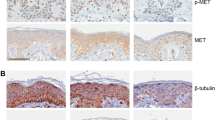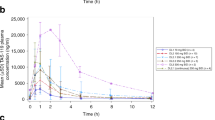Summary
Background This phase I dose-escalation study investigated the safety of the Smoothened inhibitor taladegib in Japanese patients with advanced solid tumors. Methods Patients received taladegib orally once daily for 28-day cycles, using a 3 + 3 dose-escalation method. The primary objective was the safety and tolerability of taladegib at doses up to the global recommended dose (400 mg). Secondary objectives included pharmacokinetics, changes in skin glioma-associated oncogene homolog 1 (Gli1) transcript levels, and antitumor activity. Results Nineteen patients received treatment (100 mg: 3; 200 mg: 3; 400 mg: 13). No dose-limiting toxicities (DLTs) were observed at doses of 100 mg or 200 mg; 3 of the 9 patients evaluable for DLTs at the 400 mg dose level experienced DLTs (thrombocytopenia: 1; decreased appetite: 2). The most commonly reported treatment-related adverse events were dysgeusia (13/19, 68.4%), decreased appetite (12/19, 63.2%), nausea (9/19, 47.4%), fatigue (9/19, 47.4%), and vomiting (6/19, 31.6%). The pharmacokinetic profile suggested that exposure to taladegib was higher in Japanese than non-Japanese patients, possibly related to differences in body weight and/or drug formulation. At all dose levels, a high level of inhibition of skin Gli1 transcript levels was observed after 15 and 30 days of exposure to taladegib. Partial response was achieved by 1 patient (basal cell carcinoma of the skin) and stable disease by 4 patients. Conclusions Taladegib doses of 100 mg and 200 mg, but not the global recommended dose of 400 mg, were well tolerated in this population of Japanese patients with advanced solid tumors.



Similar content being viewed by others
References
Jiang J, Hui CC (2008) Hedgehog signaling in development and cancer. Dev Cell 15:801–812
Mahindroo N, Punchihewa C, Fujii N (2009) Hedgehog-Gli signaling pathway inhibitors as anticancer agents. J Med Chem 52:3829–3845
Rimkus TK, Carpenter RL, Qasem S, Chan M, Lo HW (2016) Targeting the sonic hedgehog signaling pathway: review of smoothened and GLI inhibitors. Cancers (Basel) 8:22
Bender MH, Hipskind PA, Capen AR, Cockman M, Credille KM, Gao H, Bastian JA, Clay JM, Lobb KL, Sall DJ, Thompson ML, Wilson T, Wishart GN, Patel BKR (2011) Identification and characterization of a novel smoothened antagonist for the treatment of cancer with deregulated hedgehog signaling. Cancer Res 71(Suppl 8):Abstract 2819
Bendell J, Andre V, Ho A, Kudchadkar R, Migden M, Infante J, Tiu R, Pitou C, Tucker T, Brail L, Von Hoff D (2015) LY2940680, a hedgehog (Hh) pathway inhibitor, demonstrates antitumor activity in patients with advanced basal cell carcinoma (BCC). Mol Cancer Ther 14(Suppl 2):Abstract B32
Bendell J, Weiss G, Infante J, Ramanathan R, Jones S, Korn R, Burris H, Brail L, Jones E, Von Hoff D (2012) A phase I dose-escalation, pharmacokinetic (PK) and pharmacodynamic (PD) evaluation of LY2940680, an oral Smo inhibitor. Eur J Cancer 48(Suppl 6):Abstract 594
Eisenhauer EA, Therasse P, Bogaerts J, Schwartz LH, Sargent D, Ford R, Dancey J, Arbuck S, Gwyther S, Mooney M, Rubinstein L, Shankar L, Dodd L, Kaplan R, Lacombe D, Verweij J (2009) New response evaluation criteria in solid tumours: revised RECIST guideline (version 1.1). Eur J Cancer 45:228–247
O'Donnell PH, Dolan ME (2009) Cancer pharmacoethnicity: ethnic differences in susceptibility to the effects of chemotherapy. Clin Cancer Res 15:4806–4814
Schaefer E, Braiteh F, Forster M, Talbot D, Chandler J, Richards D, Andre V, Estrem S, Pitou C, Tiu R, Brail L, Nikolinakos P (2016) Phase 1b/2 trial of taladegib (LY2940680), a Hh/Smo inhibitor, in combination with carboplatin and etoposide followed by taladegib maintenance in extensive-stage small-cell lung cancer. Eur J Cancer 69(Suppl 1):Abstract 399
Sekulic A, Migden MR, Oro AE, Dirix L, Lewis KD, Hainsworth JD, Solomon JA, Yoo S, Arron ST, Friedlander PA, Marmur E, Rudin CM, Chang AL, Low JA, Mackey HM, Yauch RL, Graham RA, Reddy JC, Hauschild A (2012) Efficacy and safety of vismodegib in advanced basal-cell carcinoma. N Engl J Med 366:2171–2179
Chang AL, Solomon JA, Hainsworth JD, Goldberg L, McKenna E, Day BM, Chen DM, Weiss GJ (2014) Expanded access study of patients with advanced basal cell carcinoma treated with the hedgehog pathway inhibitor, vismodegib. J Am Acad Dermatol 70:60–69
Casey D, Demko S, Shord S, Zhao H, Chen H, He K, Putman A, Helms WS, Keegan P, Pazdur R (2017) FDA approval summary: Sonidegib for locally advanced basal cell carcinoma. Clin Cancer Res 23:2377–2381
Schaefer E, Braiteh F, Forster M, Talbot D, Chandler J, Richards D, Andre V, Estrem S, Pitou C, Tiu R, Brail L, Nikolinakos P (2016) Phase 1b/2 trial of taladegib (LY2940680), a Hh/Smo inhibitor, in combination with carboplatin and etoposide followed by taladegib maintenance in extensive-stage small-cell lung cancer. Poster presented at the 28th EORTC-NCI-AACR Symposium on Molecular Targets and Cancer Therapeutics, 2016 (Poster 399)
Atwood SX, Whitson RJ, Oro AE (2014) Advanced treatment for basal cell carcinomas. Cold Spring Harb Perspect Med 4:a013581
Randi G, Malvezzi M, Levi F, Ferlay J, Negri E, Franceschi S, La Vecchia C (2009) Epidemiology of biliary tract cancers: an update. Ann Oncol 20:146–159
Kim YJ, Park SB, Park JY, Park SW, Chung JB, Song SY, Bang S (2012) The sonic hedgehog pathway as a treatment target for extrahepatic biliary tract cancer. Mol Med Rep 5:12–16
Kiesslich T, Mayr C, Wachter J, Bach D, Fuereder J, Wagner A, Alinger B, Pichler M, Di Fazio P, Ocker M, Berr F, Neureiter D (2014) Activated hedgehog pathway is a potential target for pharmacological intervention in biliary tract cancer. Mol Cell Biochem 396:257–268
Riedlinger D, Bahra M, Boas-Knoop S, Lippert S, Bradtmoller M, Guse K, Seehofer D, Bova R, Sauer IM, Neuhaus P, Koch A, Kamphues C (2014) Hedgehog pathway as a potential treatment target in human cholangiocarcinoma. J Hepatobiliary Pancreat Sci 21:607–615
Zuo M, Rashid A, Churi C, Vauthey JN, Chang P, Li Y, Hung MC, Li D, Javle M (2015) Novel therapeutic strategy targeting the hedgehog signalling and mTOR pathways in biliary tract cancer. Br J Cancer 112:1042–1051
Acknowledgments
The authors would like to thank all study participants.
Funding support
This study was sponsored by Eli Lilly Japan K.K.; the manufacturer of taladegib is Eli Lilly and Company. Medical writing assistance was provided by Justine Southby, PhD, CMPP, and Tania Dickson, PhD, CMPP, of ProScribe – Envision Pharma Group, and was funded by Eli Lilly Japan K.K. ProScribe’s services complied with international guidelines for Good Publication Practice (GPP3).
Author information
Authors and Affiliations
Contributions
Eli Lilly Japan K.K. was involved in the study design, data collection, data analysis, and preparation of the manuscript.
All authors participated in the interpretation of study results, and in the drafting, critical revision, and approval of the final version of the manuscript. VA and MT were involved in the study design and statistical analysis. KI was involved in the pharmacokinetic and pharmacodynamic analyses. SK, HM, and SY were involved in the data collection. HU, SK, HM, and SY were investigators in the study.
Corresponding author
Ethics declarations
Conflicts of interest
KI and MT are employees of Eli Lilly Japan K.K. and VA is an employee of Eli Lilly and Company. VA and MT own stock in Eli Lilly and Company. HU has received research funding from Eli Lilly, Baxalta, NanoCarrier, and Taiho Pharmaceutical and has served on a Speaker’s Bureau for Taiho Pharmaceutical. HM has received honoraria from Eli Lilly Japan K.K., AstraZeneca, Boehringer Ingelheim, Bristol-Myers Squibb Japan, Chugai Pharmaceutical Co., Ltd., Clovis Oncology, Nippon Kayaku, Novartis, Ono Pharmaceutical Co., Ltd., Pfizer, Taiho Pharmaceutical, and Teijin Pharma Limited.
Ethical approval
All procedures performed in studies involving human participants were in accordance with the ethical standards of the institutional and/or national research committee and with the 1964 Helsinki declaration and its later amendments or comparable ethical standards.
Informed consent
Informed consent was obtained from all individual participants included in the study.
Rights and permissions
About this article
Cite this article
Ueno, H., Kondo, S., Yoshikawa, S. et al. A phase I and pharmacokinetic study of taladegib, a Smoothened inhibitor, in Japanese patients with advanced solid tumors. Invest New Drugs 36, 647–656 (2018). https://doi.org/10.1007/s10637-017-0544-y
Received:
Accepted:
Published:
Issue Date:
DOI: https://doi.org/10.1007/s10637-017-0544-y




